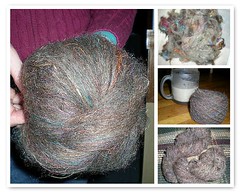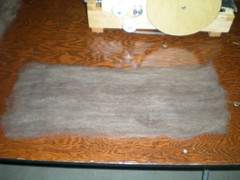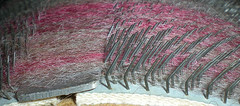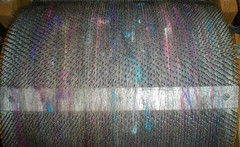 By Amelia
By AmeliaElizabeth asked me about carding; she has an Ashford fine cloth drum carder, but feels a bit limited by it. She asked,
I wonder if you have any experience with this brand and how far you think I can push it with the crazy batts. I purchased a wall paper brush to smooth the batts because they seemed to come out too coarse for me. I attribute some of that to the type of wool I am using. So far I’ve used shetland, border leiscester, south african fine, and cheviot that all come out very unrefined looking. Commercially prepped rovings of course come out much more professional looking. I wonder if other soft wools scoured right from the fleece still look untamed. I’d love to make this carder work and I’m seeking any advice you might have.
I started out with an Ashford fine too; but it started nepping and breaking the llama I was putting in it, so I didn't have it for all that long before I upgraded to a Patrick Green Supercarder. Do nothing by halves, how's that for a motto ... and an upgrade!
That said, Ashfords are not terrible carders, they're just standard drum carders. The llama was weak, and most likely any carder would have nepped it. My Patrick Green Supercarder nepped some weak merino fleece the other day...but I'm not going to throw the carder out alongside the neppy batt.
Ashford drum carders are actually quite good at arty batts, so there's no reason to get rid of it. My Ashford was in my early days, so I only did plain carding on it (one fiber at a time). But, I did get to use one recently to make some yummy silk salad batts. How textured your batt is is more a function of how far apart the teeth are, than how stiff individual teeth are, I'd hazard to say. The Ashfords' are fairly far apart, leaving room for the chunky stuff, like the sari silk, to stay chunky.
The "best" drum carders for smooth batts, in my opinion, are Strauch, Duncan (no website, contact info listed here), and the Patrick Green Supercarder -- maybe others, but those are the ones I've seen get very nice results. I've seen many makes of drum carder, but by no means all. Oh, and the Patrick Green Supercarder will smooth out most all of the texture, so if you want texture, take it "down" a step to the Strauch or Duncan. That's why I now have a Duncan, too, actually. (Well, that, and it sort of fell into my lap, grin.)
Anyway ... carding advice, that's what you asked for, right ...
Crazy batts are often highly textured things, the ones I've bought on etsy, seen in my classes, and seen out in the wild, are textured and are meant to be, honestly. But if it's the roughness of the actual underlying wool base that is getting to you, I can say that washed locks will never card as smoothly as easily as processed top or roving. And, as far as I can tell from what I've help in my hands, many of the batts on Etsy start from processed roving. Not all, though! Some start from scoured/dyed fleece ... it depends on the maker. Check the details on their listings, they may say from which point they started. Add-in fibers like bamboo, silk, or nylon most likely were processed top or sliver, as that is the most common way to find those fibers.
That's one reason why I enjoy offering Crosspatch Batts at The Bellwether -- Joan starts with wool from her own sheep; dyes them herself, and then cards them herself too. No commercially prepared wool top or roving. Yes, her silk and viscose are sliver, dyed by her and added to the batt in carding.
 There are several tips I can offer to help you come closer to smooth wool in your batts:
There are several tips I can offer to help you come closer to smooth wool in your batts:- Open the locks up fully before carding them -- take a scoured lock and spread it open, pulling the strands apart, until you can read a newspaper through it (not that that's how I test mine, but...)
- Present the locks, opened up, in line (butt first or tip first, really not relevant, just in line) to the licker-in (first drum)
- Card a batt of just the fleece, then break it into strips to make your crazy batts with -- that pre-processing will really smooth out the results, closer to what you get with processed top, without blending your crazy batt, which you probably don't want -- crazy batts quickly turn into tweeds if carded more than once.
Pre-carding the wool may seem like a lot of work, but it makes the carding of the batt go much more quickly, and lets you have a base to sandwich things inside for slippery or short fibers (silk, mohair, cashmere, silk noil...) so honestly it helps more than it slows you down.
 You can keep adding fiber onto the carder until you're near the top of the teeth, to make a batt over an ounce on your carder. This is especially helpful with these starter wool batts, the bigger they are, the less time you spend overall doffing wool batts.
You can keep adding fiber onto the carder until you're near the top of the teeth, to make a batt over an ounce on your carder. This is especially helpful with these starter wool batts, the bigger they are, the less time you spend overall doffing wool batts.The wallpaper brush helps pack it in better for a denser batt. The batt will fluff up when you take it off, so don't worry about matting. If the licker-in starts holding onto lots of fiber, that's a sign that it's reached its limit.
Oh, and, if you have handcards (or can borrow a pair to see if you like this), try holding one of those over the carder as you crank -- it may "season" the batt a bit more than the wallpaper brush for a smoother surface.
Capacity-wise, you're looking at about a 2-ounce limit on a batt on an Ashford, you should be able to get 1 ounce on there at least in materials. It takes a really big tabletop carder like the Supercarder or Duncan's Doublewide to get 3, and if you're lucky 4, ounce batts. On my supercarder I find I get 2 ounce batts pretty routinely, and if I treat them alot, with the "right" wool, I can get a 4 ounce batt. Merino maxed out at 2 ounces, but I carded some Jacob once into a thick, maxed out 4 ounce batt.
I do go through sari silk or other solid add-ins first and open up any "gobs" or major tangles. There were actually knotted bits in my sari silk, they got pulled out for sure, as they would not be good for the machine.
Not that I encourage you to be rough with it, but you'll find the drum carder's teeth are pretty sturdy. The main thing to avoid is putting hard material in, seed heads or tangles of yarn/sari silk can bend or even break off drum carder teeth faster than anything.
 Now, in terms of adding the art to your batt, there are a couple of options (at least!):
Now, in terms of adding the art to your batt, there are a couple of options (at least!):- Take the pre-carded wool batt, divide it into 1/4s or smaller bits, thin the quarter out into a carder-wide layer, "salt" it with your add-in silk/sari silk/garnetted yarn, add another widened-quarter on top, and card that onto the main drum. You may need to go thinner for it to feed in comfortably -- if your carder feels like it's getting stuck between the licker-in (first) drum and the main drum, then the sandwich needs less wool and less add-ins. Keep adding sandwiches until you've built a full batt -- it will be layers of wool/add-in/wool/add-in/wool in the final batt.
- One way to get stuff on if you are concerned about teeth damage between the drums, is to feed in a thin layer of wool (so the surface of the big drum has a film of wool on it) and then to apply your add-ins like sari silk directly to the main drum; brush them over the top, and they will "catch" on the teeth of the drum -- let them slide out of your hand as the teeth catch them. Then card another filmy layer of wool, treat the batt with your wallpaper brush or handcard, and repeat until you have a full batt.
 If you'd like more inspiration, visit my flickr set Get Batty, photos from my class, Using the Batt Machine.
If you'd like more inspiration, visit my flickr set Get Batty, photos from my class, Using the Batt Machine.Now that you have some batts ... let me recommend for further reading, How do you spin a batt?
~~
Related posts:
Who is Crosspatch Creations?
What do you teach in Using the Batt Machine?
How do you take roving off a drum carder?
I washed the fleece, now what?
What are a doffer brush and a burnishing tool used for?
When do I use oils in carding?
To Drumcard, to Handcard, or to Comb?
~~
posted 15 January 2009 at http://askthebellwether.blogspot.com/
